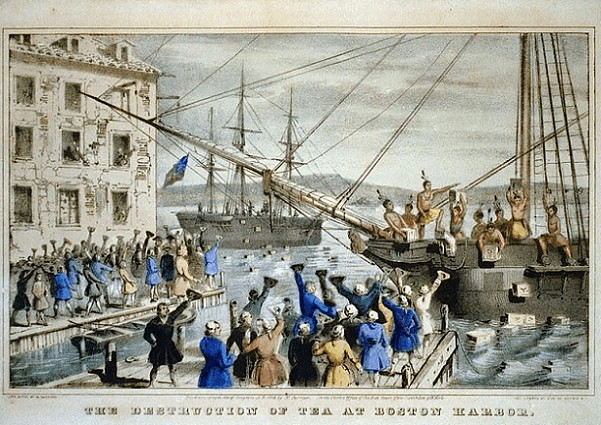Introduction: In this article, Melissa Davenport Berry writes about a little-known episode in American history: a tongue-in-cheek “Second Boston Tea Party” in 1956. Melissa is a genealogist who has a blog, AnceStory Archives, and a Facebook group, New England Family Genealogy and History.
Of course, you’ve heard about the Boston Tea Party, a protest by the Sons of Liberty in Boston Harbor on 16 December 1773 against the British Tea Act. But did you know there was a Second Boston Tea Party in American history?
And did you know they used tea from the original Boston Tea Party?
In 1956, nine men gathered in Scituate, Massachusetts, for the Second Boston Tea Party. Colonel Charles Wellington Furlong (1898-1966) hosted the event at his home “Eight Gables” on Old Oaken Bucket Road.
The attendees, from potent pedigrees, included: William Avery Baker (1911-1981), designer of the second Mayflower; Leonard Francis Cushing (1901-1962), naval architect on the Maintenance Committee, U.S. Frigate Constitution; Alden Stoddard Cook (1889-1976), great grandson of Ichabod Cook who did cabinet work on the Constitution; Commodore Frederic Abilgaard Fenger (1882-1970), yacht designer, navigator and author; Captain Alexander Forbes (1882-1965), physicist; Guiles “Giles” Melville Stuart Todd (1914-1995), who sailed around the “Horn” on one of the last square-rigged grain ships; Frank “Smithy” Vining Smith (1879-1967), noted painter of sailing ships and naval engagements; and Commodore William Marriott Welch (1878-1968), Scituate Yacht Club member who owned one of the largest collections of commemorative war medals in the world.
At the 1956 gathering, Furlong served the original “gun powder tea” taken in the raid on the East India Company ship Beaver in Boston Harbor on that December night in 1773. According to Furlong, the tea had been preserved for generations in the Danby-Larkin Estate in Boston, and he bequeathed it to Lawrence W. Jenkins (1872-1961), a former curator of the Peabody Essex Museum.
The tea was served in saucers just like it was back in the day, and Furlong gave the toast: “To the gentlemen who stood for no taxation without representation!”
Captain Hezekiah Coffin, a Quaker mariner, was in command of Beaver the night of the original Boston Tea Party. After dropping off sperm whale oil to London, Captain Coffin was to transport the British East India Company tea to Boston. The Beaver held 112 chests of tea when she arrived at Griffin’s Wharf in Boston on Wednesday, 15 December 1773 – she was delayed as a result of a case of smallpox which broke out onboard and was held in quarantine for two weeks in Boston’s outer harbor.
The history behind the Brick Kiln Yard at Pembroke where Beaver was built is detailed in the History of Shipbuilding on North River, Plymouth County, Massachusetts: With Genealogies of the Shipbuilders, Kent, and Accounts of the Industries Upon Its Tributaries. 1640 to 1872, written by Lloyd Vernon Briggs. Many famous crafts, privateers, whalers, and merchant vessels were forged in the Brick Kiln Yard.
Captain Ichabod Thomas SR (1733-1788) was the master builder for the Beaver. He was commissioned by Quaker merchant William Rotch of Nantucket in 1772.
During his time in the Brick Kiln Yard, Thomas built Bedford, the first vessel to display the United States flag in foreign waters, off Trinity, England, 6 February 1783; and Neptune, commanded by Captain Nathan Coffin, who was captured by the Brits on a voyage to London with a load of whale oil. The British Admiral said: “Capt. Coffin, you can join His Majesty’s service, or go into irons.” Coffin replied: “Hang me, if you will, to your ship’s yard-arm, but do not ask me to become a traitor to my country.”
Another of Thomas’ ships, Maria, was depicted on Pembroke’s town seal and put in at nearly every seaport of the globe, remaining in commission for 90 years. The Somerset, under the command of Alexander Coffin, carried the papers of Benjamin Franklin announcing the Treaty with France.
The master carpenters who worked on these ships were also skilled in cabinetmaking. During the American Revolution, the Corps of Artificers, or “Company of Carpenters” – comprised of a select group of highly skilled craftsmen – were formed to produce necessary goods.
I have been researching the list of carpenters who served in these corps, and many came out of the old shipyards in Plymouth County and other parts of New England. I have uncovered family history and business advertisements in GenealogyBank’s historical newspapers, account books, and examples of their work in archival collections. Some of the surnames: Stetson, Cushing, Lincoln, Barker, Vassall, Colby, Humphries, Plummer, Briggs, Hatch, Jaques, Thaxter, Stone, Beal, Jackson, and Nichols.
Additional Reading:
- Read one of Furlong’s articles “Land of the Men of Kent” online at Scituate Historical Society.
- Also check out Traits of the Tea Party, a memoir of George Hewes, a Tea Party participant, 1835.
Related Article:
